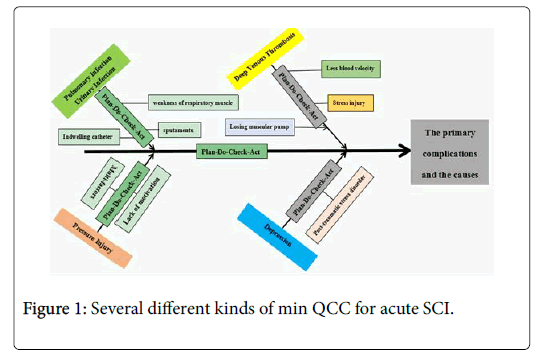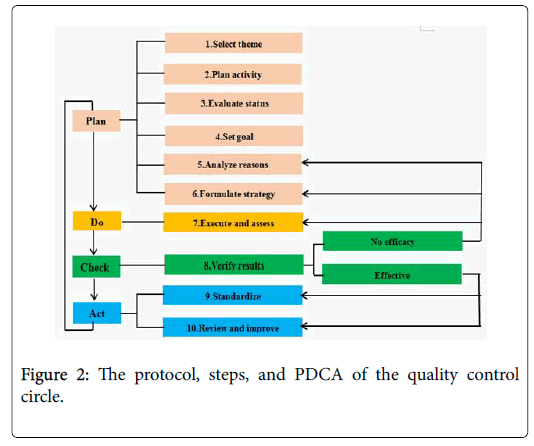The Application of Combined Quality of Control Circle for Acute Spinal Cord Injury
Received: 30-Nov-2018 / Accepted Date: 12-Dec-2018 / Published Date: 19-Dec-2018 DOI: 10.4172/2165-7386.1000351
Introduction
Acute Spinal Cord Injury (SCI) are usually caused by high energy and often leads to high paraplegia, many serve complications or death. The majority of complications include pulmonary or urinary infection, and deep venous thrombosis [1]. Actually, patient often occurs feeling of anxiety and despair at the time of hospitalization. The effective nursing interventions may help patients to go through difficult times, and help them to decrease mortality rate, and help them to extend their life spans. Quality of Control Circle (QCC) as a comprehensive and scientific management model that has achieved some good results in the nursing field in China [2]. Several published studies proved that teamwork with application of QCC can improve efficiency and reduce mortality [3-5]. However, there are also empty patches for usage of QCC in acute SCI patient. Thus, the aim of this Min-review is to present combined QCC as a support to patient with acute SCI. The new strategies of nursing care according to the QCC model as a concept will be proposed.
Methods
The QCC program was launched based on the theory of QCC [6], and the main targets or causes of QCC program for nursing strategies of acute spinal cord injury were outlined (Table 1). The roles of QCC program consisted of project director, counselor, circle head and circle members. Actually, our QCC was composed of several different kinds of min QCC according to the types of complications of caused by trauma (Figure 1). We followed the protocol of PDCA (Plan-Do- Check-Act), which proposed by Lei Lin et al. [7] (Figure 2).
| The types of complications | Main Causes | Main Targets | Nursing Strategies | The Numbers of Min QCC |
|---|---|---|---|---|
| Pulmonary and Urinary Infection | 1. The weakness of respiratory muscle. 2. The sputamentum located in airway. 3. Indwelling catheter for long term |
Prevention of urinary or pulmonary Infection | 1. The management of tracheal suctioning. 2. Turning over their back. 3.Pulmonary function training. 4. Bladder irrigation, perineal care. |
Nurses rehabilitation physician Nurses rehabilitation physician Physician Nurses Physician Family members of patients Nurses Nurses Clinical Psychologist Physician |
| Deep Venous Thrombosis | 1. Losing muscular pump. 2. Stress injury. 3. Less blood velocity. | Prophylactic treatment for venous thromboembolism | 1. Prophylactic usage of drugs. 2. Mechanical prophylaxis. | |
| Pressure Injury | 1. Personnel and mechanical factors. 2. Lack of motivation. 3. Factors of environment. | Prevention of pressure injury | 1. Turning over their body with regularity. 2. Usage of air bed. 3. A reasonable diet. 4. Bladder irrigation, perineal care. | |
| Depression | 1. Post-traumatic stress disorder. | Psychological care | 1. Palliative or hospice care. |
Table 1: The characteristics and tasks of Min QCC.
Discussion
Several complications will be occurrence in patient with acute SCI, which consist of pulmonary and urinary infection, deep venous thrombosis, pressure injury, and depression. These complications occur subsequently or together may cause severe results or lead to death for acute SCI patient [8]. Some study proved that the effective nursing care and reasonable treatment will extend their life spans for acute SCI patient. QCC model as an effective measurement that had been used to copy with problems occurred in nursing field in China, which follows the “PDCA” (Plan-do-check-act) process [7]. In this min review, the QCC of acute SCI may help nurse improve their professional ability. After accepting training for the concept of min QCC aiming at acute SCI, nurses acquire a new pattern of treatment to a “forward-looking” prevention pattern. We will propel the clinical application of combined QCC for the acute SCI patient in the future.
References
- Lavis T, Goetz LL (2019) Comprehensive care for persons with spinal cord injury. Phys Med Rehabil Clin N Am 30: 55-72.
- Feng YH, Cao YR (2013) QCC management mode in the clinical application of dynamic management to prevent the stress injury. Nurs Pract Res 10: 89-91.
- Feng H, Li G, Xu C, Ju C, Suo PA (2017) A quality control circle process to improve implementation effect of prevention measures for high-risk patients. Int Wound J 14: 1094-1099.
- Chen P, Yuan T, Sun Q, Jiang L, Jiang H, et al. (2016) Role of quality control circle in sustained improvement of hand hygiene compliance: An observational study in a stomatology hospital in Shandong, China. Antimicrob Resist Infect Control 5: 54.
- Chen H, Liao W, Wang T, Xia J, Cui F, et al. (2018) Application of quality control circle in reducing incidence of leakage in digestive endoscopy. Zhongguo Yi Liao Qi Xie Za Zhi 42: 384-387.
- Wang LR, Wang Y, Lou Y, Li Y, Zhang XG (2013) The role of quality control circles in sustained improvement of medical quality. Springerplus 2: 141.
- Lei Lin, Pingjun Chang, Jialu Xie, Zhangliang Li, Hongfang Zhang, Fan Lu & Yun-e Zhao (2017) Sustained accuracy improvement in intraocular lens power calculation with the application of quality control circle. Springer
- Schilero GJ, Bauman WA, Radulovic M (2018) Traumatic spinal cord injury: Pulmonary physiologic principles and management. Clin Chest Med 39: 411-425.
Citation: Liu M, Zhang L, Zhang J, Zhong W, Yang C, et al. (2018) The Application of Combined Quality of Control Circle for Acute Spinal Cord Injury . J Palliat Care Med 9:351. DOI: 10.4172/2165-7386.1000351
Copyright: © 2018 Liu M, et al. This is an open-access article distributed under the terms of the Creative Commons Attribution License, which permits unrestricted use, distribution, and reproduction in any medium, provided the original author and source are credited.
Select your language of interest to view the total content in your interested language
Share This Article
Recommended Journals
Open Access Journals
Article Tools
Article Usage
- Total views: 4800
- [From(publication date): 0-2019 - Dec 15, 2025]
- Breakdown by view type
- HTML page views: 3852
- PDF downloads: 948


